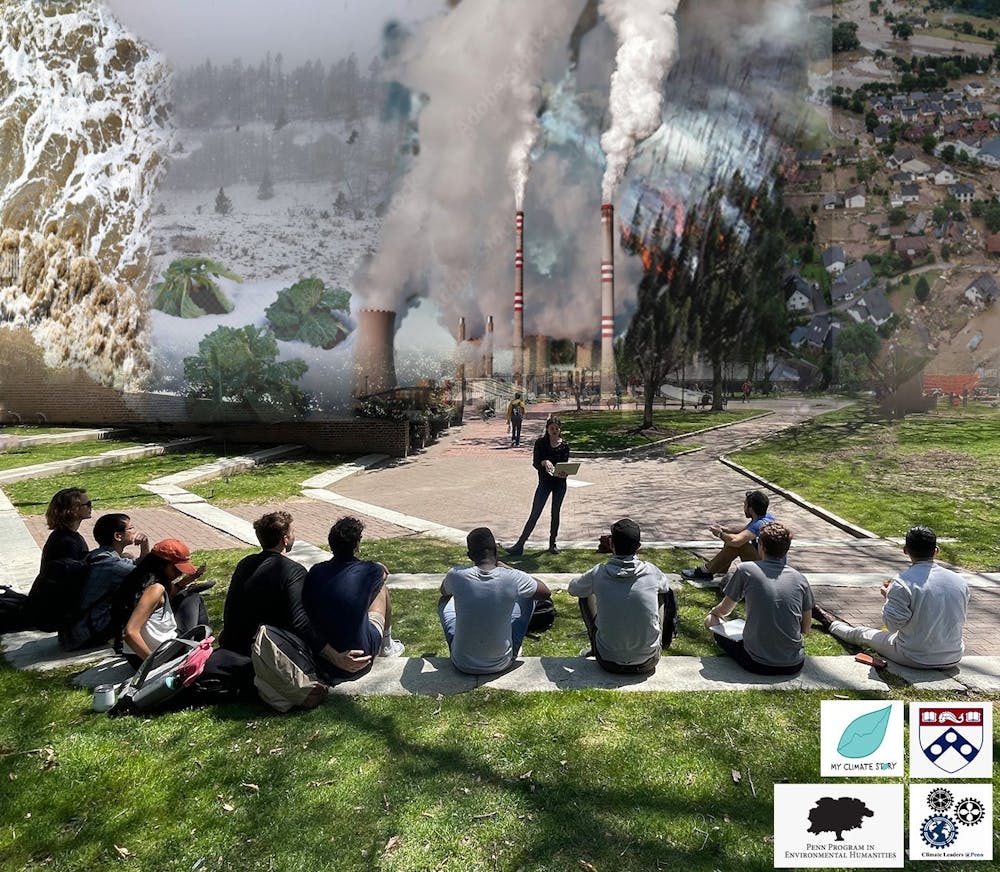Climate change is afoot, but young people feel their voices are too small to make a change. But the Penn Program in Environmental Humanities (PPEH) is using their new project, "My Climate Story," to remind students, "know that your story is enough."
A smattering of similar encouragements live in a 74–page cookbook of recipes that wants students to orient their S.I.S.Rs—Setting, Impact, Senses, and Reflection—to bring their climate stories to life. This project is a colorful, glossy spiral book full of recipes for workshops, writing exercises, and storytelling resources, all geared towards helping young folks find their voice in the fight against climate change and help quell climate anxiety.
The PPEH, founded at Penn in 2014, facilitates interdisciplinary research on the environment while its projects utilize art–centric focus to address environmental justice in the Philadelphia community.
Most recently, the PPEH, along with its team of interns, crafted this book with the purpose of providing educators with a tool to foster climate conversation. These recipes, accompanied by charming illustrations, bring the climate crisis to students in a personal way.
This cookbook is just one element of "My Climate Story," their public storytelling project. Currently, "My Climate Story" brings together ten high school teachers from schools in Philadelphia who want to bring climate discussion into their classrooms, regardless of the subject they teach. Teachers and the PPEH work together to create a climate curriculum that encourages students to recognize how climate change is impacting them and develop the skills to share their stories with the world.
"My Climate Story" was born from a class in environmental humanities that Bethany Wiggin, the co–founder of the PPEH, taught for Philadelphia teachers. Meeting with the teachers, she was surprised to learn that only one teacher out of 30 she met with taught about climate change in their class. As she dug deeper into climate education, she was especially horrified to discover the lack of climate education in this country. The teachers agreed—they wanted to teach about the climate, but they simply didn’t have anything to teach. To fill this gap, Wiggin began thinking about ways to bring climate change to schools in an impactful way.
After returning to her family home in Maine, she noticed the trees on her property were dying as a result of rising seawater, and she was struck by the emotional impact it had on her. "My Climate Story" began with this memory that unearthed the power of connecting climate change to people’s life experiences.
While the project begins with the stories of high school students in Philadelphia, the end goal is to incite national policy change. Yes, climate policy already exists—we’ve heard countless times about a carbon tax, cap–and–trade, or green energy funding. However, "My Climate Story" serves up a fresh new take on climate policy education.
Many of our current climate conversations are inaccessible. Climate is dispensed to us through numbers: meters of sea level rise, parts per million of greenhouse gases, years left on the Climate Clock. Millennials and Gen Z have been hearing about their impending climate doom for most of their lives, and climate anxiety affects our daily lives. Young people all over the world feel sad, afraid, anxious, angry, and powerless. "My Climate Story" seeks to replace those feelings with human connection and resilience.
Rather than being inundated with statistics about global warming, students in these classrooms are asked to identify events in their lives that have to do with climate change. Students struggled at first to come up with anything, and most of us in Philadelphia would probably feel the same. There’s been no destructive hurricane, no raging wildfire, and no deadly drought—how can we come up with a compelling climate story?
This is where the cookbook helps students attune to the impacts of climate change around them. Recipes provide a space for students to research endangered animals or interview each other about their experiences.
Philadelphia is an amazing place for this initiative to begin—young people here are especially committed to social justice issues. Wiggin wants to harness this for the "Climate Story" project: “Philadelphia is an important place where we can really accelerate the work that's happening with schoolchildren.”
On Oct. 13 of this year, hundreds of these Philadelphia students gathered at Irvine Auditorium on Penn’s campus. They’ve known that other high schools in Philadelphia are involved in this project, but this is the first time they’ve come together to hear each others’ stories.
Wiggin believes “climate resilience cannot start unless we have a broadly educated community.” Two crucial steps for climate resilience are passing policies introducing climate literacy and investing in resources for a nationwide climate curriculum.
Bringing climate education to people in a human way is a relatively new idea that’s encapsulated in “environmental humanities.” This term was coined only about 12 years ago to deal with the amount of impact that humans have had on this planet. It’s meant to bring people who are trained in the study of culture, values, ethics, and artistic expression to the table to add to the climate conversation.
This approach has the power to transcend the political associations with climate change. Working with people’s lived experiences, Wiggin says, has been amazingly apolitical. The climate movement is really about resilience and survival in the end, and the disruption climate change causes is spans beyond political beliefs. Whether or not someone understands the science of climate change, they will notice their roads flooding or their crops dwindling.
"My Climate Story" is not just about telling your own story; it’s about building a network to share and listen. Reading and sharing climate stories is open to anyone. Share your story on the "My Climate Story" website, and join voices from around the world that give the immensity of climate change a human meaning.

